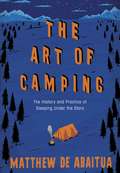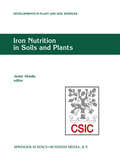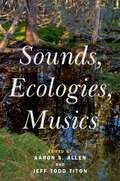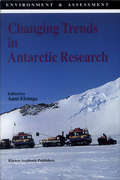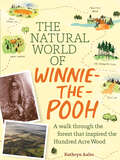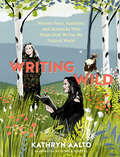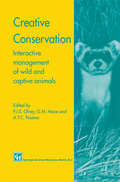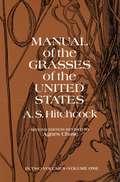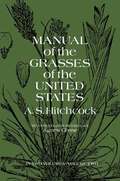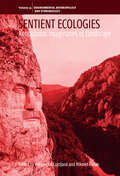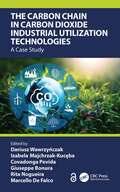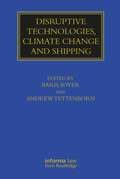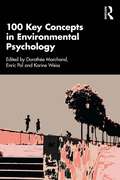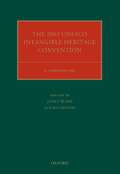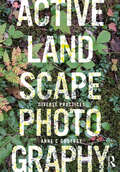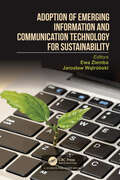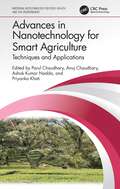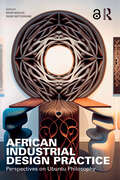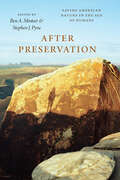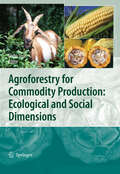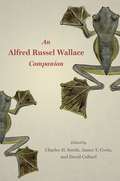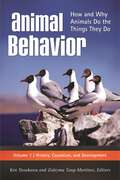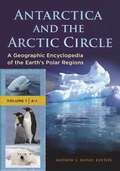- Table View
- List View
The Art of Camping: The History and Practice of Sleeping Under the Stars
by Matthew De AbaituaCould there be another way of life? Can I survive with less stuff? Should I run for the hills?These are all good questions that people have asked before, throughout history, and which have inspired people to set up camp. But now camping is part of the drive for self-sufficiency, a reaction against mass tourism, a chance to connect with the land, to experience a community, to leave no trace . . . From packing to pitching, with hikes into the deep history of the subject and encounters with the great campers and camping movements of the past, this is the only book you'll need to pack when you next head off to sleep under the stars.IF THERE IS ONE THING THAT CAMPERS LIKE MORE THAN CAMPING, IT'S DREAMING ABOUT THEIR NEXT TRIP
Iron Nutrition in Soils and Plants: Proceedings of the Seventh International Symposium on Iron Nutrition and Interactions in Plants, June 27–July 2, 1993, Zaragoza, Spain (Developments in Plant and Soil Sciences #59)
by Javier AbadíaIron is a major constituent of the earth crust. However, under alkaline conditions commonly found in arid and semi-arid environments iron becomes unavailable to plants. When plants are affected by a shortage of iron their leaves become yellow (chlorotic), and both plant growth and crop yield are reduced. The roots of plants affected by iron deficiency may develop a series of responses directed to improve iron uptake, such as increased proton excretion and iron reduction capabilities or excretion of iron chela tors called siderophores. Iron deficiency affects major crops worldwide, including some of major economic importance such as fruit trees and others. Correction of iron deficiency is usually implemented through costly application of synthetic chelates. Since these correction methods are very expensive, the competitivity of farmers is often reduced and iron deficiency may become a limiting factor for the maintenance, introduction or expansion of some crops. In spite of the many years devoted to the study of iron deficiency, the knowledge of iron deficiency in soils and plants is still fragmentary in many aspects. We have only incomplete information on the processes at the molecular level that make some plant species and cultivars unable to take and utilize iron from the soil, whereas other plants grow satisfactorily under the same conditions.
Sounds, Ecologies, Musics
by Aaron S. Allen and Jeff Todd TitonSounds, Ecologies, Musics poses exciting challenges and provides fresh opportunities for scholars, scientists, environmental activists, musicians, and listeners to consider music and sound from ecological standpoints. Authors in Part I examine the natural and built environment and how music and sound are woven into it, how the environment enables music and sound, and how the natural and cultural production of music and sound in turn impact the environment. In Part II, contributors consider music and sound in relation to ecological knowledges that appear to conflict with, yet may be viewed as complementary to, Western science: traditional and Indigenous ecological and environmental knowledges. Part III features multidisciplinary and interdisciplinary approaches by scholars, scientists, and practitioners who probe the ecological imaginary regarding the complex ideas and contested keywords that characterize ecomusicology: sound, music, culture, society, environment, and nature. A common theme across the book is the idea of diverse ecologies. Once confined to the natural sciences, the word "ecology" is common today in the social sciences, humanities, and arts - yet its diverse uses have become imprecise and confusing. Engaging the conflicting and complementary meanings of "ecology" requires embracing a both/and approach. Diverse ecologies are illustrated in the methodological, terminological, and topical variety of the chapters as well as the contributors' choice of sources and their disciplinary backgrounds. In times of mounting human and planetary crises, Sounds, Ecologies, Musics challenges disciplinarity and broadens the interdisciplinary field of ecomusicologies. These theoretical and practical studies expand sonic, scholarly, and political activism from the diversity-equity-inclusion agenda of social justice to embrace the more diverse and inclusive agenda of ecocentric ecojustice.
Changing Trends in Antarctic Research (Environment & Assessment #3)
by AantElzingaThe core of this volume is a report from a symposium held at the University of Goteborg in the Fall of 1991. It deals with the interplay of science and politics and how^ such interplay affects research agendas. The focus is on polar research in Antarctica, a continent that has been much in the news during the past couple of years. It gives me particular pleasure to thank all the speakers who took part in the program. All of them have many commitments and involvements in international polar research and the protection of Antarctica for its scientific and aesthetic values. The fact that such a distinguished group has been willing to come to Goteborg, to my mind attests to the importance and timeliness of our topic and the relevance of epistemological and policy issues in this field. A presentation of each speaker and author is made within the relevant chapters in the text. My interest in the Antarctic has its origins in discussions with Anders Karlqvist, the Director of the Swedish Polar Research Secretariate at the Royal Academy of Science in Stockholm. Anders and I had worked together in the early 80's in a program on Technology and Culture, among other at the Research Policy Institute in Lund. At the time he was with the Swedish Council for Planning and Coordination of Research (FRN), its Committee for Future Oriented Research headed by Torsten Hagerstrand.
The Natural World of Winnie-the-Pooh: A Walk Through the Forest that Inspired the Hundred Acre Wood
by Kathryn AaltoA New York Times Bestseller This charmingly illustrated book explores the real landscape of the Ashdown Forest, A. A. Milne's inspiration for the Hundred Acre Wood, the magical realm in which Winnie-the-Pooh and his friends lived and played.
Writing Wild: Women Poets, Ramblers, and Mavericks Who Shape How We See the Natural World
by Kathryn AaltoWriting Wild, by New York Times-bestselling author Kathryn Aalto, explores the lasting impact of 25 women writers whose pens have left an indelible mark on the world of nature writing.
Creative Conservation: Interactive management of wild and captive animals
by A. T. C.Feistner G. M. Mace P. J. S.OlneyPast progress and future challenges R.J. Wheater Royal Zoological Society of Scotland, Edinburgh, UK. In the past two decades much has been achieved in the sphere of breeding endangered species, and we should be pleased that our co operative efforts have already borne so much fruit. However, on balance and despite the best efforts of conservationists, the position of wildlife in the wild places where they are best conserved has become worse, often dramatically worse. Before returning to the United Kingdom in 1972, I was in Uganda for 16 years, most of which time was spent as Chief Warden of Murchison Falls National Park. Our main problem was that an over-population of large mammals was having a devastating impact on the habitat. Devas tation was being wrought on woodland areas by the arrival of large numbers of elephants into the sanctuary of the Park, following changes in land use in the areas outside the Park. These changes were in response to the requirements of an ever-expanding human population.
Manual of the Grasses of the United States, Volume One
by A. S. U.S. Dept. of Agriculture A. S. HitchcockThis work is actually the definitive encyclopedia of United States grass life. Compiled from the U.S. National Herbarium collection, the largest of its kind in the world, it is the only complete manual of U.S. grasses available and one of the basic reference works on U.S. plant life. It catalogs and describes in detail all 1,398 numbered species in 169 numbered genera found in this country, plus 120 species in 16 genera of the so-called “waifs.” Professor Hitchcock is the former Chief Botanist in charge of systematic agrostology for the U.S. Department of Agriculture, by whom the work was originally published, and an internationally known authority.The heart of the book is its detailed descriptions of the family of grasses, the two main subfamilies, the tribes, genera, and species. Quick finding keys are provided for the identification of tribes and genera. Each of the species is given thorough botanical description, including various aspects of its morphology — size, shape, form of culms, blades, panicles, spikes, and flowers — and height, proper planting season, and range of distribution are noted. The Manual also outlines the common uses to which grasses are put and discusses in general terms their distribution, classification, nomenclature, and common names. The 1,199 drawings make identification of any grass species found in the United States a virtual certainty. The appended synonymy of alternate names for each species provides an authoritative taxonomy, eliminating confusion.The nature lover with no more technical equipment than a keen eye can use this manual with profit, for a glossary of botanical terms is included. Naturalists, botanists, agriculturists, and horticulturists will find it valuable as a field and research guide to virtually all the grasses that grow in this country.
Manual of the Grasses of the United States, Volume Two
by A. S. U.S. Dept. of Agriculture A. S. HitchcockThis work is actually the definitive encyclopedia of United States grass life. Compiled from the U.S. National Herbarium collection, the largest of its kind in the world, it is the only complete manual of U.S. grasses available and one of the basic reference works on U.S. plant life. It catalogs and describes in detail all 1,398 numbered species in 169 numbered genera found in this country, plus 120 species in 16 genera of the so-called “waifs.” Professor Hitchcock is the former Chief Botanist in charge of systematic agrostology for the U.S. Department of Agriculture, by whom the work was originally published, and an internationally known authority.The heart of the book is its detailed descriptions of the family of grasses, the two main subfamilies, the tribes, genera, and species. Quick finding keys are provided for the identification of tribes and genera. Each of the species is given thorough botanical description, including various aspects of its morphology — size, shape, form of culms, blades, panicles, spikes, and flowers — and height, proper planting season, and range of distribution are noted. The Manual also outlines the common uses to which grasses are put and discusses in general terms their distribution, classification, nomenclature, and common names. The 1,199 drawings make identification of any grass species found in the United States a virtual certainty. The appended synonymy of alternate names for each species provides an authoritative taxonomy, eliminating confusion.The nature lover with no more technical equipment than a keen eye can use this manual with profit, for a glossary of botanical terms is included. Naturalists, botanists, agriculturists, and horticulturists will find it valuable as a field and research guide to virtually all the grasses that grow in this country.
Sentient Ecologies: Xenophobic Imaginaries of Landscape (Environmental Anthropology and Ethnobiology #31)
by Alexandra Co 539 Ofan 259 Hikmet KuranEmploying methodological perspectives from the fields of political geography, environmental studies, anthropology, and their cognate disciplines, this volume explores alternative logics of sentient landscapes as racist, xenophobic, and right-wing. While the field of sentient landscapes has gained critical attention, the literature rarely seems to question the intentionality of sentient landscapes, which are often romanticized as pure, good, and just, and perceived as protectors of those who are powerless, indigenous, and colonized. The book takes a new stance on sentient landscapes with the intention of dispelling the denial of “coevalness” represented by their scholarly romanticization.
The Carbon Chain in Carbon Dioxide Industrial Utilization Technologies: A Case Study
by Dariusz Wawrzy 324 Czak Izabela Majchrzak-Kucę Ba Covadonga Pevida Giuseppe Bonura Rita Nogueira Marcello De FalcoA shift towards implementation of renewable energy has disadvantages, such as power availability, storage capacity, and accompanying costs, and therefore the potential of clean fossil fuel technologies to ensure the stability of electricity generation needs to be reconsidered until these challenges will be overcome. These clean technologies can help prevent the greenhouse effect and, at the same time, guarantee energy security, as coal is a widespread, price-stable raw material that is available in large quantities. This book focuses on the carbon chain, starting from the formation of CO2, through its capture, possible cleaning, to the production of useful products such as dimethylether, methanol, and carbonated cement prefabricates. The comprehensive case study presents the research results of an international team established within the "CCS-CCU technology for carbon footprint reduction using bio-adsorbents" (BIOCO2) project.
Disruptive Technologies, Climate Change and Shipping (Maritime and Transport Law Library)
by Bar 305 351 Soyer Andrew TettenbornThis book analyses the impact of two vital and contemporary developments on shipping law and practice: disruptive technologies and climate change. It considers the impact of these new technologies, honing in on likely emerging issues and unresolved questions, especially about existing and potential private law liabilities and concentrates, from the point of view of English, EU and international law, on the legal implications of climate change and associated environmental risks in the shipping sector. Written by a contributor team drawn from the most experienced and knowledgeable academics and practitioners in shipping law, this treatment of these growing areas of practice will be of great use to lawyers and administrators across the world.
Coastal Architectures and Politics of Tourism: Leisurescapes in the Global Sunbelt
by Sibel Bozdo 287 An Panayiota Pyla Petros PhokaidesThis volume offers a critical and complicated picture of how leisure tourism connected the world after the World War II, transforming coastal lands, traditional societies, and national economies in new ways.The 21 chapters in this book analyze selected case studies of architectures and landscapes around the world, contextualizing them within economic geographies of national development, the geopolitics of the Cold War, the legacies of colonialism, and the international dynamics of decolonization. Postwar leisure tourism evokes a rich array of architectural spaces and altered coastal landscapes, which is explored in this collection through discussions of tourism developments in the Mediterranean littoral, such as Greece, Turkey, and southern France, as well as compelling analyses of Soviet bloc seaside resorts along the Black Sea and Baltic coasts, and in beachscapes and tourism architectures of western and eastern hemispheres, from Southern California to Sri Lanka, South Korea, and Egypt. This collection makes a compelling argument that "leisurescapes," far from being supra-ideological and apolitical spatial expressions of modernization, development, and progress, have often concealed histories of conflict, violence, social inequalities, and environmental degradation. It will be of interest to architectural and urban historians, architects and planners, as well as urban geographers, economic and environmental historians.
عمدة الطبيب في معرفة النبات
by يحيى مراددراسة التراث وتاريخ العلوم عند العرب والمسلمين، أمر لابدّ منه في مرحلة التحوّل التي تمر بها الأمة العربية. ذلك لأن اطلاع أبنائها على المنجزات العلمية التي حققها الأجداد في الماضي، لابدّ أن يكون باعثاً على الثقة في النفوس، وحافزاً لحث الخطى في طريق التقدم العلمي والتقني الذي نسعى لتحقيقه. ومن واجب التراث علينا أن نتصدى بأنفسنا لكشف مكنوناته، ونشر روائعه، وإلقاء الضوء على مدى مساهمته في إغناء المعرفة والعلم خلال قرون عديدة، بعد أن ظل هذا العمل مقتصراً على المستشرقين الذين ينتمون إلى أمم مختلفة. وفي مكتباتنا العربية العامة والخاصة كثير من المخطوطات القيّمة، والكتب النافعة التي لم تدرس حتى الآن، ولاسيّما في موضوع الطب والصيدلة وعلم النبات والتي كان لها سماتها، فأدت دوراً كبيراً في إثراء العلوم وبث روح الحياة. حيث كان يلتقي النبات والدواء في مسيرة واحدة لتأمين الغذاء النافع والدواء الناجع. لقد توافرت للعرب ثروة معرفيّة ولغويّة هائلة حين انصرفوا إلى الطبيعة، كغيرهم من الأمم التي سبقتهم، فوجدوا أن الأرض تزخر بالخيرات، من شجر وعشب وبقل وتابل وغذاء، فانصرفوا إلى "علم الفلاحة" ودراسة النباتات. وألّفوا في ذلك كتباً كثيرة لها أهميتها في ميادين علوم النبات والصيدلة والطب وغيرها. وكانت عنايتهم بأصناف النبات نابعة من حاجتهم إلى الغذاء والدواء معاً. وإلى التطيب بالعطور، وصناعة الصباغة والدباغة، وتركيب المواد الصيدلانية من جذور وقشور وثمار وبذور وأعشاب نباتات مختلفة. وهكذا أصبحت المعاجم العربية، والمؤلفات العلمية، غنية بكم وافر من الأسماء والمصطلحات النباتية، وضمَّت معارف العرب المسلمين القدماء في علمي الطب والنبات. فكانت مصدراً لمن ألف وكتب في المفردات النباتية والغذائية والدوائية. وهي كثيرة العدد نذكر منها: "كتاب النبات" لأبي حنيفة الدينوري(1) ت 282هـ-895م)، وكان من أكثر المعاجم جمعاً للمادة، وأعظمها أثراً في معاجم النبات التي ألفت فيما بعد.
100 Key Concepts in Environmental Psychology
This accessible book defines 100 key concepts, ideas and processes in Environmental Psychology to provide an introductory reference work that brings together research and theory in a bite-size format. With contributions from leading figures within Environmental Psychology, each concept is clearly defined and explained within the context of issues around the environment, sustainability, climate change, nature and architecture. This book considers the involvement of psychological, physiological and social processes to understand the mechanisms that explain and contribute to the evolution of behavior and attitudes that relate to our relationship with the environment. Concepts covered include biodiversity, eco-anxiety, place identity, sustainable behaviour, climate justice and environmental attitudes. By integrating ideas from different disciplinary orientations in the field of Environmental Psychology, this book allows for a better understanding of the processes related to the individual-environment relationship, as well as the applications that they allow for in various fields of intervention. This is essential reading for students and researchers in Environmental Psychology, Sustainability Studies, Architecture and Built Environment Studies and related fields.
The 2003 UNESCO Intangible Heritage Convention: A Commentary (Oxford Commentaries on International Cultural Heritage Law)
This book critically analyses the 2003 Convention for the Safeguarding of the Intangible Cultural Heritage, UNESCO's latest and ground-breaking treaty in the area of cultural heritage protection. Intangible cultural heritage is broadly understood as the social processes that inform our living cultures, and our social cohesion and identity as communities and peoples. On the basis of this conception, the Treaty proposes to turn our understanding of how, for whom, and why heritage is safeguarded on its head, by putting communities, groups and individuals at the centre of the safeguarding process. The commentary, written by leading experts in the field from all continents and multiple disciplines, provides an authoritative guide to interpreting and implementing not only this Treaty, but also its ripple effects on how we think about cultural heritage and our experience with it as a part of our living cultures. This book is of interest to lawyers, policy-makers, anthropologists, cultural diplomacy specialists, archaeologists, cultural heritage studies experts, and, foremost, the people who practice and enact this heritage.
Active Landscape Photography: Diverse Practices (Active Landscape Photography)
Diverse Practices, the third book in the Active Landscape Photography series, presents a set of unique photographic examples for site-specific investigations of landscape places. Contributed by authors across academia, practice and photography, each chapter serves as a rigorous discussion about photographic methods for the landscape and their underlying concepts. Chapters also serve as unique case studies about specific projects, places and landscape issues. Project sites include the Miller Garden, Olana, XX Miller Prize and the Philando Castile Peace Garden. Landscape places discussed include the archeological landscapes of North Peru, watery littoral zones, the remote White Pass in Alaska, Sau Paulo and New York City’s Chinatown. Photographic image-making approaches include the use of lidar, repeat photography, collage, mapping, remote image capture, portraiture, image mining of internet sources, visual impact assessment, cameraless photography, transect walking and interviewing. These diverse practices demonstrate how photography, when utilized through a set of specific critical methods, becomes a rich process for investigating the landscape. Exploring this concept in relationship to specific contemporary sties and landscape issues reveals the intricacy and subtlety that exists when photography is used actively. Practitioners, academics, students and researchers will be inspired by the underlying concepts of these examples and come away with a better understanding about how to create their own rigorous photographic practices.
Adoption of Emerging Information and Communication Technology for Sustainability
This book represents an important voice in the discourse on the adoption of emerging ICT for sustainability. It focuses on how emerging ICT acts as a crucial enabler of sustainability, offering new forward-looking approaches to this field. The book explores how emerging ICT adoption drives sustainability efforts in business and public organizations, promoting ecological, economic, social, cultural, and political sustainability. The book's theoretical discussions, conceptual approaches, empirical studies, diverse perspectives, and views make it a valuable and comprehensive reference work. Appealing to both researchers and practitioners, this book provides significant areas for research and practice related to the contribution of emerging ICT adoption to sustainability. It also suggests vital considerations for programming and building sustainable development-driven emerging ICT adoption. Readers will find answers to important contemporary questions, such as: What are the concepts, frameworks, models, and approaches to enhance sustainable development through the adoption of emerging ICT? How does the adoption of emerging ICT influence sustainability? How can emerging ICT be adopted to enhance sustainability? What are the current practices and successful cases of emerging ICT adoption for sustainability? What factors influence emerging ICT adoption to enhance sustainability?
Advances in Nanotechnology for Smart Agriculture: Techniques and Applications (Microbial Biotechnology for Food, Health, and the Environment)
The yield of major agricultural crops can be severely decreased due to the inappropriate application of commonly used harmful chemicals. Excessive agrochemicals in field application can negatively affect microbial populations and their diversity, which in turn ultimately affects plant growth. Thus, it is necessary to turn toward more eco-friendly approaches which equally protect crops as well as the desirable microbial populations of complex soil systems. Nanoparticles are considered as potential agents for the production and development of sustainable agriculture. Green synthesis of nanoparticles has gained attention as a useful measure to diminish the harmful effects associated with the old methods of nanoparticle synthesis. Advances in Nanotechnology for Smart Agriculture: Techniques and Applications illustrates the science and practical applications of nanoparticles for sustainable agriculture. Features: Examines the role of nanotechnology in agricultural best practices, including sustainable development, precision farming, and long-term soil health
African Industrial Design Practice: Perspectives on Ubuntu Philosophy
The underlying principle of this book is the African philosophy of Ubuntu, which acts as a guide for developing empathic products and services. The book makes the case that empathy is the key to any successful product and service design project because it enables designers to make wise design choices that align with users' demands.Fifteen chapters provide the latest industrial design developments, techniques, and processes explicitly targeting emerging economies. At the outset, it covers the design context and the philosophy of the Ubuntu approach, which places people and communities at the centre of the development agenda. The book covers new product development, design research, design cognition, digital and traditional prototyping, bringing products to the market, establishing a company's brand name, intellectual property rights, traditional knowledge, and the business case for design in Afrika. It concludes with a discussion about the future of design and the skills aspiring designers will need.African Industrial Design Practice: Perspectives on Ubuntu Philosophy will be an essential textbook for undergraduates, postgraduates, instructors, and beginner designers in emerging economies to provide regionally contextualised design processes, illustrated examples, and outcomes.Chapter 2 of this book is freely available as a downloadable Open Access PDF at http://www.taylorfrancis.com under a Creative Commons Attribution-Non Commercial-No Derivatives (CC-BY-NC-ND) 4.0 license.
After Preservation: Saving American Nature in the Age of Humans
From John Muir to David Brower, from the creation of Yellowstone National Park to the Endangered Species Act, environmentalism in America has always had close to its core a preservationist ideal. Generations have been inspired by its ethos—to encircle nature with our protection, to keep it apart, pristine, walled against the march of human development. But we have to face the facts. Accelerating climate change, rapid urbanization, agricultural and industrial devastation, metastasizing fire regimes, and other quickening anthropogenic forces all attest to the same truth: the earth is now spinning through the age of humans. After Preservation takes stock of the ways we have tried to both preserve and exploit nature to ask a direct but profound question: what is the role of preservationism in an era of seemingly unstoppable human development, in what some have called the Anthropocene? Ben A. Minteer and Stephen J. Pyne bring together a stunning consortium of voices comprised of renowned scientists, historians, philosophers, environmental writers, activists, policy makers, and land managers to negotiate the incredible challenges that environmentalism faces. Some call for a new, post-preservationist model, one that is far more pragmatic, interventionist, and human-centered. Others push forcefully back, arguing for a more chastened and restrained vision of human action on the earth. Some try to establish a middle ground, while others ruminate more deeply on the meaning and value of wilderness. Some write on species lost, others on species saved, and yet others discuss the enduring practical challenges of managing our land, water, and air. From spirited optimism to careful prudence to critical skepticism, the resulting range of approaches offers an inspiring contribution to the landscape of modern environmentalism, one driven by serious, sustained engagements with the critical problems we must solve if we—and the wild garden we may now keep—are going to survive the era we have ushered in. Contributors include: Chelsea K. Batavia, F. Stuart (Terry) Chapin III, Norman L. Christensen, Jamie Rappaport Clark, William Wallace Covington, Erle C. Ellis, Mark Fiege, Dave Foreman, Harry W. Greene, Emma Marris, Michelle Marvier, Bill McKibben, J. R. McNeill, Curt Meine, Ben A. Minteer, Michael Paul Nelson, Bryan Norton, Stephen J. Pyne, Andrew C. Revkin, Holmes Rolston III, Amy Seidl, Jack Ward Thomas, Diane J. Vosick, John A. Vucetich, Hazel Wong, and Donald Worster.
Agroforestry for Commodity Production: Ecological and Social Dimensions
Agroforestry systems have been touted as sustainable production systems that alleviate many of the environmental problems associated with modern production systems. Are they indeed ecologically and economically sustainable? Using case studies from around the globe, this book highlights the potential of agroforestry systems to produce a broad range of commodities. In addition to addressing the biophysical and socioeconomic dimensions of producing traditional food, fodder and fiber crops, this volume examines the potential to integrate biomass crops, botanicals and ornamental plants into agroforestry practices. The book should be particularly useful to students, professionals, researchers and policy makers involved in natural resource management, agroforestry, and environmental management.
An Alfred Russel Wallace Companion
Although Alfred Russel Wallace (1823–1913) was one of the most famous scientists in the world at the time of his death at the age of ninety, today he is known to many as a kind of “almost-Darwin,” a secondary figure relegated to the footnotes of Darwin’s prodigious insights. But this diminution could hardly be less justified. Research into the life of this brilliant naturalist and social critic continues to produce new insights into his significance to history and his role in helping to shape modern thought. Wallace declared his eight years of exploration in southeast Asia to be “the central and controlling incident” of his life. As 2019 marks one hundred and fifty years since the publication of The Malay Archipelago, Wallace’s canonical work chronicling his epic voyage, this collaborative book gathers an interdisciplinary array of writers to celebrate Wallace’s remarkable life and diverse scholarly accomplishments. Wallace left school at the age of fourteen and was largely self-taught, a voracious curiosity and appetite for learning sustaining him throughout his long life. After years as a surveyor and builder, in 1848 he left Britain to become a professional natural history collector in the Amazon, where he spent four years. Then, in 1854, he departed for the Malay Archipelago. It was on this voyage that he constructed a theory of natural selection similar to the one Charles Darwin was developing, and the two copublished papers on the subject in 1858, some sixteen months before the release of Darwin’s On the Origin of Species. But as the contributors to the Companion show, this much-discussed parallel evolution in thought was only one epoch in an extraordinary intellectual life. When Wallace returned to Britain in 1862, he commenced a career of writing on a huge range of subjects extending from evolutionary studies and biogeography to spiritualism and socialism. An Alfred Russel Wallace Companion provides something of a necessary reexamination of the full breadth of Wallace’s thought—an attempt to describe not only the history and present state of our understanding of his work, but also its implications for the future.
Animal Behavior [3 volumes]: How and Why Animals Do the Things They Do [3 volumes]
Discover why animals do what they do, based on their genes, physiologies, cultures, traditions, survival and mating advantages, and evolutionary histories—and find out how studying behavior in the animal world helps us understand human behavior.The three volumes of Animal Behavior: How and Why Animals Do the Things They Do cover the breadth of the field, addressing causation, development, function, and evolution in a wide range of animals, from invertebrates to humans. Inspired by Nobel laureate Nikolaas Tinbergen's work, the first two volumes follow Tinbergen's four classic questions of animal behavior, while the third volume supplies integrated examples of Tinbergen's investigative process applied in specific cases.Written in an engaging, accessible manner ideal for college students as well as general audiences, this evidence-based collection provides a fascinating tour of animal behaviorists' findings, such as how animal communication can be truthful or deceitful, the deadly serious business behind clashes in the "battle of the sexes," and how documentation of animal behavior can lead to a deeper understanding of human behavior. Each chapter provides both historical background and information about current developments in animal behavior knowledge.
Antarctica and the Arctic Circle [2 volumes]: A Geographic Encyclopedia of the Earth's Polar Regions [2 volumes]
This one-stop reference is a perfect resource for anyone interested in the North and South Poles, whether their interest relates to history, wildlife, or the geography of these regions in the news today.Global warming, a hot topic among scholars of geography and science, has led to increased interest in studying the earth's polar ice caps, which seem to be melting at an alarming rate. This accessible, two-volume encyclopedia lays a foundation for understanding global warming and other issues related to the North and South Poles. Approximately 350 alphabetically arranged, user-friendly entries treat key terms and topics, important expeditions, major figures, territorial disputes, and much more.Readers will find information on the explorations of Cook, Scott, Amundsen, and Peary; articles on humpback whales, penguins, and polar bears; and explanations of natural phenomena like the Aurora Australis and the polar night. Expedition tourism is covered, as is climate change. Ideal for high school and undergraduate students studying geography, social studies, history, and earth science, the encyclopedia will provide a better understanding of these remote and unfamiliar lands and their place in today's world.
